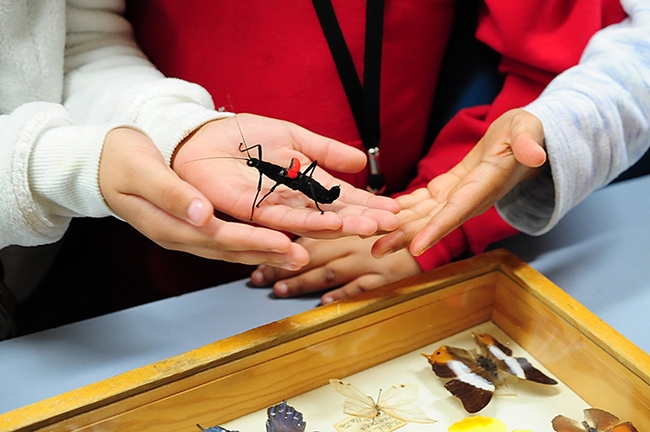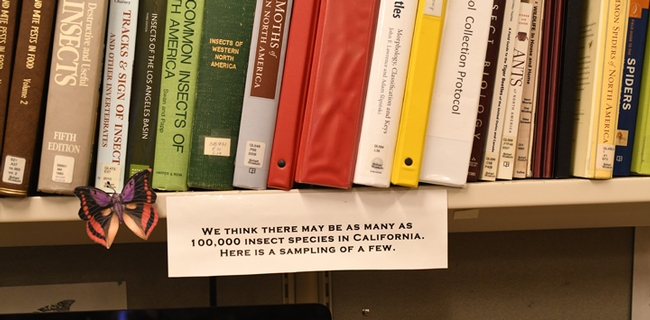- Author: Kathy Keatley Garvey
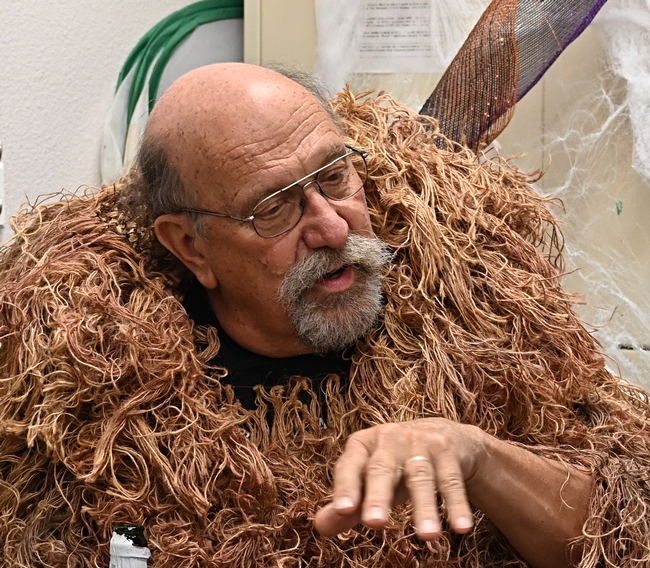
The predators and their prey were all in costumes, of course:
- The queen bee: UC Davis distinguished professor Lynn Kimsey, director of the Bohart Museum
- The praying mantis: Tabatha Yang, education and outreach coordinator of the Bohart Museum
- The green darner dragonfly: Christofer Brothers, a UC Davis doctoral candidate researching dragonflies
- The monarch: Barbara Heinsch, a Bohart Museum volunteer, who arrived with her entomologist-husband, Mike Pitcairn, retired senior environmental scientist, supervisor, California Department of Food and Agriculture (CDFA). He wore his CDFA lab coat and swung an insect net.
And the guy in the ghillie suit serving beverages (that would be forensic entomologist Robert "Bob" Kimsey of the UC Davis Department of Entomology and Nematology) is keenly interested in flies, but he didn't net the fly.
UC Davis entomology alumna Ivana Li, a biology lab manager at UC Davis, catered the event and arrived with her dog, Juniper, dressed as a taco. Lynn Kimsey cut a carrot cake, decorated with tiny carrots and large googly eyes.
Some attendees, including Joanna Chiu, professor and chair of the Department of Entomology and Nematology; UC Davis doctoral alumna Fran Keller, professor at Folsom Lake College; Bohart Museum associate Greg Karofelas; UC Davis doctoral alumnus Dick Meyer (who studied with the late Richard Bohart); and entomology student Kaitai Liu, arrived as themselves, sans Halloween costumes.
The Bohart Museum, located in Room 1124 of the Academic Surge Building, 455 Crocker Lane, houses a global collection of eight million insect specimens, plus a live insect petting zoo and a gift shop. Founded in 1946 by the late UC Davis professor Richard Bohart, it has been directed by Kimsey, his former doctoral student, since 1990. (See more Halloween images on the UC Davis Department of Entomology and Nematology website)
Next Open House on Monarchs. The Bohart's next open open house, set from 1 to 4 p.m., Saturday, Nov. 4, is on monarchs.
The event, free and family friendly, will be held in Room 1124 of the Academic Surge Building, Crocker Lane. This is an opportunity for attendees to ask questions about monarchs (Danaus plexippus) and native vs. non-native milkweed, among other topics.
The scientists will include:
- UC Davis distinguished professor emeritus Art Shapiroof the Department of Evolution and Ecology, who has studied butterfly populations in central California since 1972 and maintains a research website, Art's Butterfly World.
- UC Davis emeritus professor Hugh Dingle, a worldwide authority on animal migration, including monarchs. He is the author of Migration: The Biology of Life on the Move (Oxford University Press), a sequel to the first edition published in 1996. See news story on the UC Davis Entomology and Nematology website.
- UC Davis professor Louie Yang, who does research on monarchs. Due to parental duties, he may be able to attend only the last part of the open house. See news story about his work.
- UC Davis professor Elizabeth Crone of the Department of Evolution and Ecology, formerly of Tufts University, who researches monarchs. See news story about the declining monarch population on the UC Davis Entomology and Nematology website.
- UC Davis postdoctoral fellow Aramee Diethelm of the Elizabeth Crone lab. She holds a doctorate from the University of Nevada, Reno. Both her Ph.D. and postdoctoral work are on monarch butterflies. As a doctoral student, she investigated the phytochemical landscape of milkweed (Asclepias) species across northern Nevada and the effects of this variation on western monarch (Danaus plexippus) butterfly performance. See her research posted on Google Scholar, and her blog on "Drought Influences Monarch Host Plant Selection."
Shapiro points out that the monarch "is NOT a focal species in my research and I am NOT a monarch expert. On the other hand, I have a unique breeding-season census data set starting in 1999. The only other census data are for the overwintering roosts on the coast. It has become apparent that the two data sets do not always agree." Shapiro said he'd talk briefly about this at the open house.
The Bohart Museum, founded in 1946, houses a global collection of eight million insect specimens; a live insect petting zoo; and a gift shop. It is located in Room 1124 of the Academic Surge Building, 455 Crocker Lane. For more information, access the website or email bmuseum@ucdavis.edu.
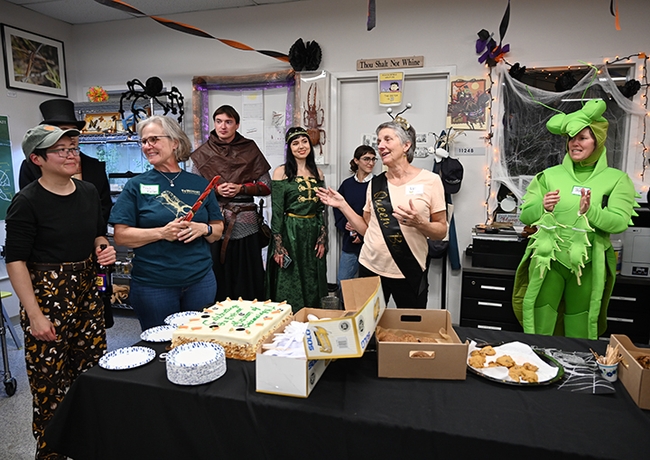
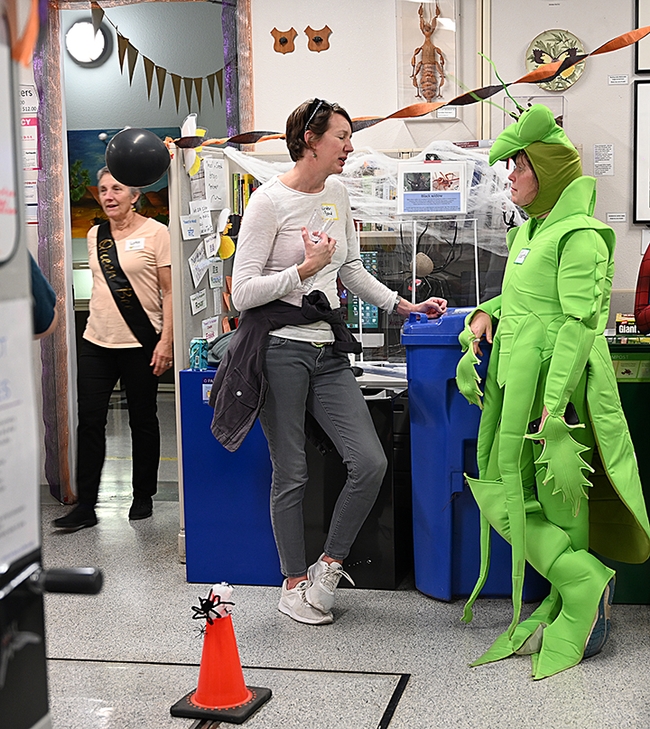
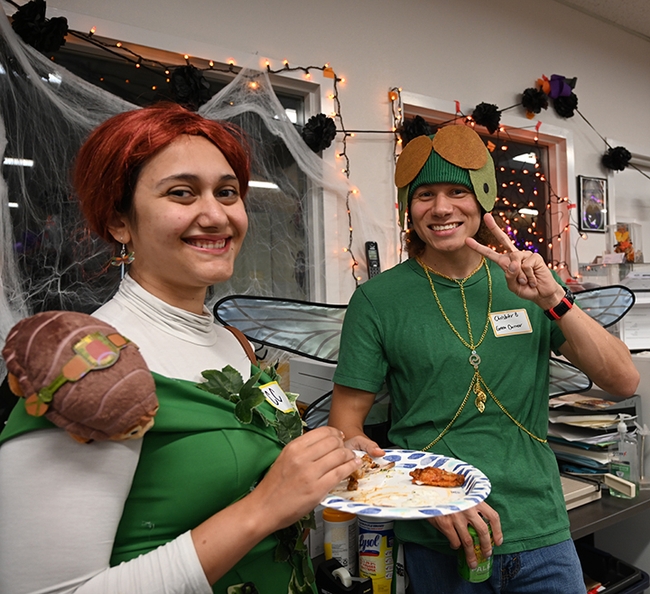
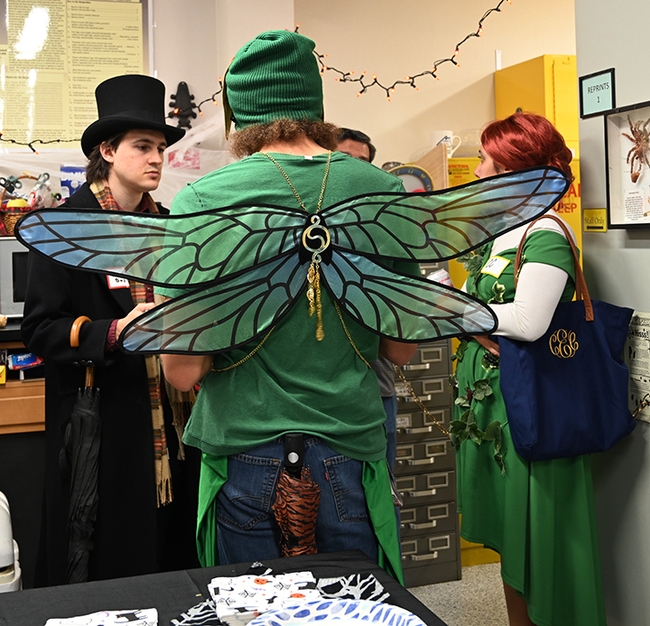
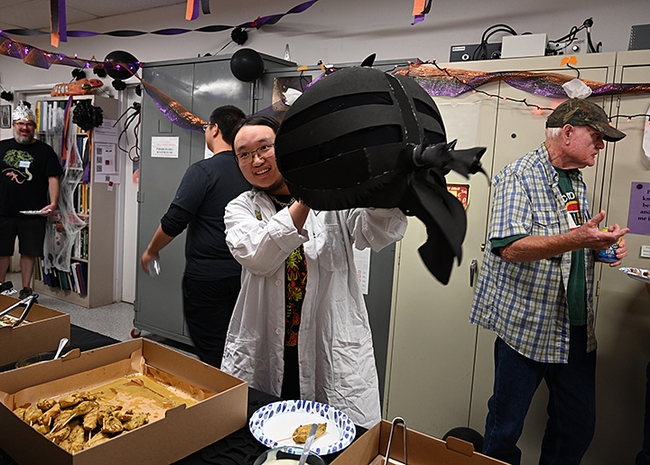
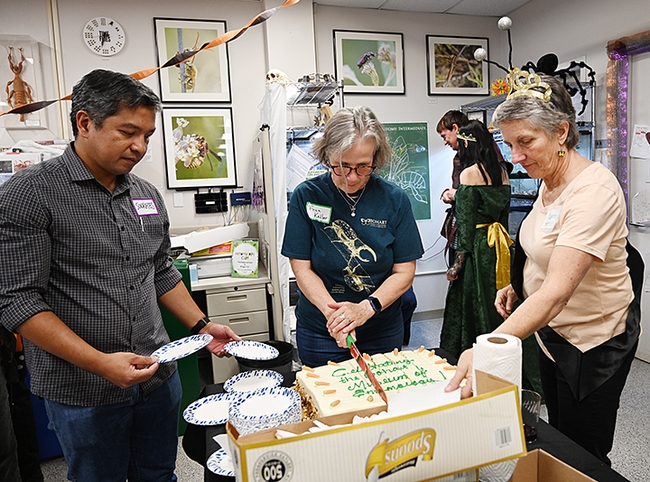
- Author: Kathy Keatley Garvey

The Bohart Museum of Entomology at UC Davis boasts one of the world's largest tardigrade (water bear) collections, and what Lynn Kimsey wants to do, will certainly add to that point.
Kimsey, director of the Bohart Museum and UC Davis professor of entomology, plans to grace the entrance with a tardigrade sculpture, a concrete sculpture that will measure about 4 feet by eight feet.
"I've been in touch with the sculptor Solomon Bassoff (Faducciart) in Roseville," Kimsey said. "He did the caterpillar in the Davis Central Park."
"The reason for this is that we have one of the world's largest tardigrade collections, which was compiled by (senior museum scientist) Steve Heydon's predecessor, Bob Schuster," she said. "Tardigrades are really popular with kids in part because of their representation in the movies Ant-Man and Ant-Man and the Wasp, Star Trek and Family Guy."
Kimsey wrote about the tardigrades in her newsletter several years ago. The water bear "has to be one of the most peculiar and indestructible groups of animals known," she wrote. The microscopic and nearly indestructible tardigrade can survive being heated to 304 degrees Fahrenheit or being chilled for days at -328 F. And, even if it's frozen for 30 years, it can still reproduce." See video on EurekAlert.
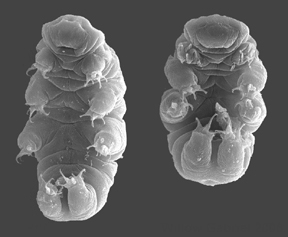
The Bohart collection includes some 25,000 slide-mounted specimens. Kimsey and collaborator Carl Johannsen work on a National Science Foundation grant "to database and conserve" the collection.
"This collection is the result of years of collecting, mounting, imaging, and identifying by former collection manager Bob Schuster and emeritus professor Al Grigarick and their collaborators," she noted.
In appearance, the pudgy water bear seems as cuddly as a teddy bear. It has a barrel-shaped body and eight pudgy legs. The adults usually range from 0.3 to 0.5 mm in length.
German zoologist Johann August Ephraim Goeze (1731-1793) first described the critters in 1773, referring to them as "kleiner Wasserbär," or "little water bears."
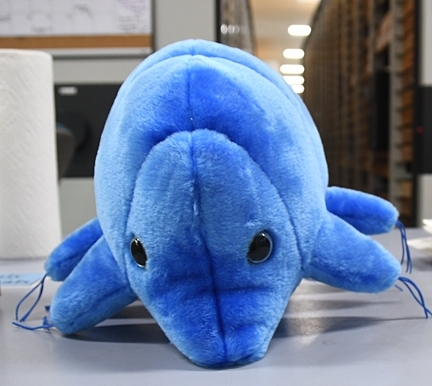
They mostly feed on plants or bacteria "but some are predators on smaller tardigrades," Kimsey says. They use the stylets in their tubular mouth (snout) to pierce "individual plant or bacterial ells or small invertebrates."
Why is the water bear so indestructible? In research published in 2016, geneticist Takekazu Kunieda and his colleagues from the University of Tokyo found that the water bear expresses a tardigrade-specific protein that binds itself to DNA. This acts like a "shield against x-ray radiation, preventing the DNA from snapping apart," according to an article published in Gizmodo.
"Tardigrades are awesome," Kimsey said. "They can dry out completely and then become immortal. In fact, SpaceIL may have left thousands of dried tardigrades on the moon when it crashed earlier this year."
Stuffed toy water bears are also popular in the Bohart Museum's gift shop, which also includes insect-themed books, posters, t-shirts, jewelry, candy, and insect collecting equipment.
The museum, located in Room 1124 of the Academic Surge Building on Crocker Lane, houses nearly 8 million insect specimens, collected globally. It also maintains a live "petting zoo" featuring Madagascar hissing cockroaches, walking sticks and tarantulas.
And soon, there may very well be a tardigrade out front. The Bohart Museum Society has set up an account on Go Fund Me; see https://www.gofundme.com/f/waterbear-sculpture
Comments on Go Fund Me include:
- Great initiative that I am happy to support!
- Tardigrades were some of my childhood friends
- Favis seems like a great place for a tardigrade sculpture! I'm inspired by the tardigradologists & nematologists I've admired there. A eutardigrade seems like it'd be less prone to causing injuries, but I can support a heterotardigrade :)
- Robert Schuster, UCD Bohart Museum, was instrumental in my career studying tardigrades. He taught me how to identify the species (known at that time) and how to use the SEM. His tardigrade collection is housed in the Bohart Museum.
The Bohart Museum entrance may be "bare" today, but when a water bear arrives, one thing's for sure: kids and adults alike will love it "beary" much.
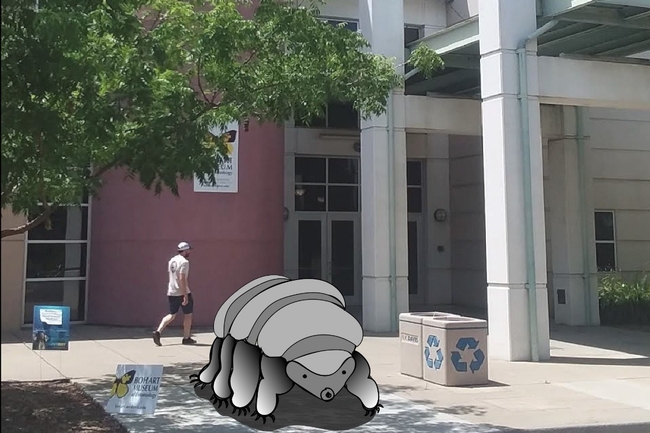
- Author: Kathy Keatley Garvey
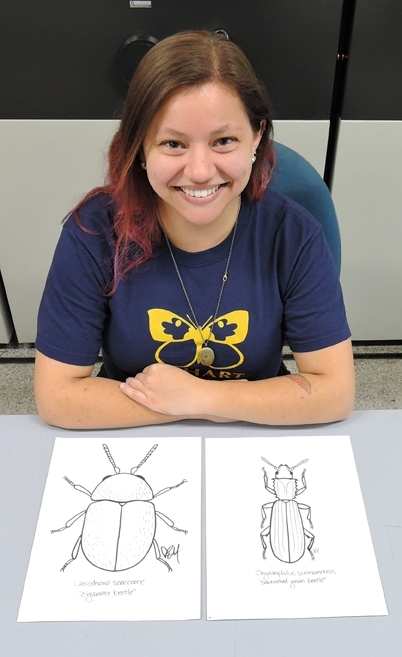
They do.
Just check out the Bohart Museum of Entomology's newly published calendar.
"Mr. January" is a locust sitting quite comfortably in a chair--a swivel chair at that--and eagerly accessing a dating site. "You've got a match!" the screen informs him.
Yippee! You can almost hear him yelling "Yippee."
The caption reads: "Normally, locusts are introverted creatures; they do not socialize unless it is for reproduction."
The rest of the story: Lynn Kimsey, director of the Bohart Museum of Entomology and longtime professor of entomology at the University of California, Davis, collects unusual answers on the student tests she administers. You can imagine how many sentences comprise her collection: she joined the faculty back in 1989!
The "dating locust" is one of 12 from the Lynn Kimsey Prized Collection that made it into the Bohart's first-ever calendar. UC Davis entomology major Karissa Merritt, a talented artist and scientist known for her creativity and sense of humor, interpreted and illustrated all the sentences.
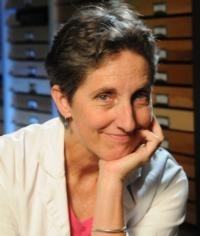
The calendar, a project of the non-profit Bohart Museum Society, sells for $12, plus tax, at the Bohart Museum, located in Room 1124 of the Academic Surge Building on Crocker Lane. (More information is available on the website or by contacting bmuseum@ucdavis.edu or (530) 753-0493.) It's also available in the UC Davis Department of Entomology and Nematology administration office in 367 Briggs Hall.
Those who contribute $50 or more to the Bohart Museum Society will receive a calendar with their donation. All proceeds are earmarked for research, education and outreach projects.
Merritt says insects fascinate her. She's amazed at how "alien their biology and morphology are as compared to vertebrates." She's also drawn to their beauty and diversity.
Professor Kimsey, who holds a doctorate in entomology from UC Davis, directs the world-renowned Bohart Museum, home of eight million specimens, a year-around gift shop and a live "petting zoo" which includes Madagascar hissing cockroaches, walking sticks and tarantulas. She specializes in bees, wasps and insect diversity.
And collecting sentences--many apparently from sleep- or caffeine-deprived students.
"Normally, locusts are introverted creatures; they do not socialize unless it is for reproduction."
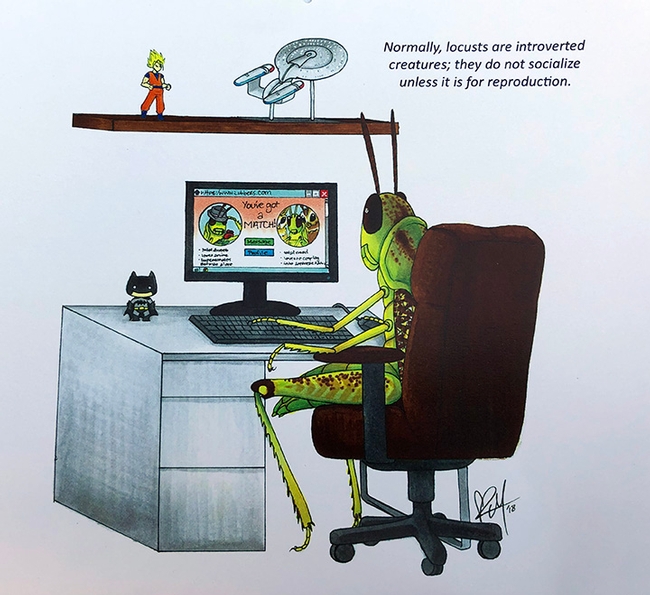
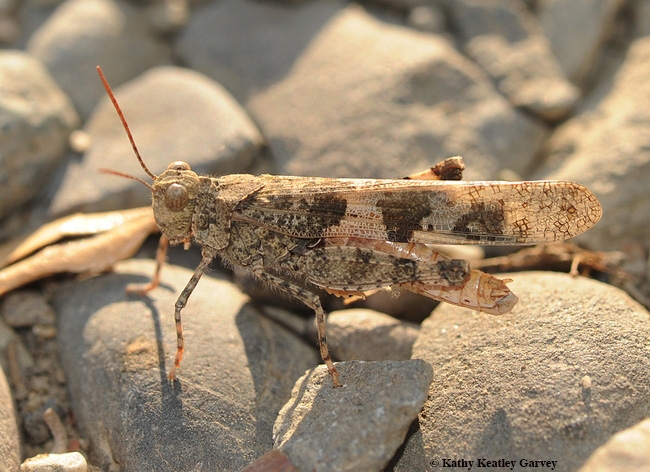
- Author: Kathy Keatley Garvey

The Bohart Museum, located in Room 1124 of the Academic Surge Building on Crocker Lane on the UC Davis campus, is the home of nearly 8 million specimens collected worldwide. It also houses the seventh largest insect collection in North America, and the California Insect Survey, a storehouse of the insect biodiversity.
Said Lynn Kimsey, professor of entomology and director of the Bohart Museum: "We have big plans for the coming year and your support or continued support will make it possible for us to:
- Continue our K-12 outreach programs
- Train undergraduate and graduate students in educational outreach
- Keep our website up-to-date
- Educate the public about insects and spiders
- Develop new training programs
- Finance collecting expedition"
Over the past year, the Bohart has added new collections of beetles and butterflies and "we have two awesome imaging systems that have made it possible for us to provide scientists and digital visitors high-quality images of insects in our collections," Kimsey said.
The Bohart Museum offers the following categories of memberships: Individual: $25; Student: $15; Student Families: $25; Family: $40; and Patron: $100.
Donors can also contribute to the exhibits, biolegacy sponsorship (get an insect named for you or a loved one), and to the museum endowment.
Memberships and gifts are tax-deductible to the extent allowable by law. Checks may be made payable to the Bohart Museum Society and mailed to:
The Bohart Museum Society
Department of Entomology and Nematology
University of California
Davis, CA 95616
Or, donors may wish to pay online by accessing http://bohart.ucdavis.edu
The Bohart Museum is open to the public from 9 a.m. to noon and 1 to 5 p.m. Mondays through Thursdays. It is closed to the public on Fridays, Saturdays and Sundays and on major holidays. Admission is free. The museum also hosts special open houses throughout the academic year.
Special attractions are a live "petting zoo" (think Madagascar hissing cockroaches, walking sticks, tarantulas and praying mandids) and a year-around gift shop filled with insect-collecting equipment, books, T-shirts, sweatshirts, jewelry, posters, and insect-themed candy.
More information on the Bohart Museum is available by contacting (530) 752-0493 or emailing bmuseum@ucdavis.edu or Tabatha Yang at tabyang@ucdavis.edu.
